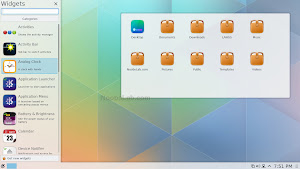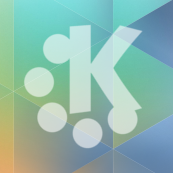KDE is an international technology team that creates free and open source software for desktop and portable computing. Among KDE's products are a modern desktop system for Linux and UNIX platforms, comprehensive office productivity and groupware suites and hundreds of software titles in many categories including Internet and web applications, multimedia, entertainment, educational, graphics and software development. KDE software is translated into more than 60 languages and is built with ease of use and modern accessibility principles in mind. KDE's full-featured applications run natively on Linux, BSD, Solaris, Windows and Mac OS X.
"KDE team announces the immediate availability of Plasma 5.0, providing a visually updated core desktop experience that is easy to use and familiar to the user. Plasma 5.0 introduces a new major version of KDE's workspace offering. The new Breeze artwork concept introduces cleaner visuals and improved readability. Central work-flows have been streamlined, while well-known overarching interaction patterns are left intact. Plasma 5.0 improves support for high-DPI displays and ships a converged shell, able to switch between user experiences for different target devices. Changes under the hood include the migration to a new, fully hardware-accelerated graphics stack centered around an OpenGL(ES) scenegraph. Plasma is built using Qt 5 and Frameworks 5."
Screenshots






What's major in Plasma 5:
Note: Before installing in Ubuntu 14.04/Linux Mint 17, you must have already installed KDE plasma desktop or Kubuntu desktop.
Project Neon is available as PPAs which offers frequently updated development snapshots of KDE Frameworks. Also keep in mind that PPA contains daily/unstable builds, so be prepare to face bugs.
To install Plasma 5.0 framework in Kubuntu 14.04/Ubuntu 14.04 Trusty/Linux Mint 17 open Terminal (Press Ctrl+Alt+T) and copy the following commands in the Terminal:
For other distributions you can even build from source or download images to test it.
That's it
"KDE team announces the immediate availability of Plasma 5.0, providing a visually updated core desktop experience that is easy to use and familiar to the user. Plasma 5.0 introduces a new major version of KDE's workspace offering. The new Breeze artwork concept introduces cleaner visuals and improved readability. Central work-flows have been streamlined, while well-known overarching interaction patterns are left intact. Plasma 5.0 improves support for high-DPI displays and ships a converged shell, able to switch between user experiences for different target devices. Changes under the hood include the migration to a new, fully hardware-accelerated graphics stack centered around an OpenGL(ES) scenegraph. Plasma is built using Qt 5 and Frameworks 5."






What's major in Plasma 5:
- An updated and modernized, cleaner visual and interactive user experience: The new Breeze theme is a high-contrast, flat theme for the workspace. It is available in light and dark variants. Simpler and more monochromatic graphics assets and typography-centered layouts offer a clean and visually clear user experience.
- Smoother graphics performance thanks to an updated graphics stack: Plasma's user interfaces are rendered on top of an OpenGL or OpenGL ES scenegraph, offloading many of the computational-intensive rendering tasks. This allows for higher framerates and smoother graphics display while freeing up resources of the main system processor.
- Converged shell: The "converged Plasma shell" that loads up the desktop in Plasma 5.0 can be extended with other user experiences. This lays the base for a converged user experience bringing up a suitable UI for a given target device. User experiences can be switched dynamically at runtime, allowing, based on hardware events such as plugging in a keyboard and a mouse.
- Modernized launchers: The application launchers' user interfaces have been reworked. Among the changes are a visually redesigned Kickoff application launcher, a newly included, more menu-like launcher, called Kicker and a new, QtQuick-based interface for KRunner.
- Workflow improvements in the notification area: The notification area has been cleaned up, and sports a more integrated look now. Less popup windows and quicker transitions between for example power management and networks settings lead to a more distraction-free interaction pattern and greater visual coherence.
- Better support for high-density (high-DPI) displays: Support for high-density displays has been improved. Many parts of the UI now take the physical size of the display into account. This leads to better usability and display on screens with very small pixels, such as Retina displays.
- Converging User Experience
- Fully Hardware-Accelerated Graphics Stack
- Suitability and Updates
Note: Before installing in Ubuntu 14.04/Linux Mint 17, you must have already installed KDE plasma desktop or Kubuntu desktop.
Project Neon is available as PPAs which offers frequently updated development snapshots of KDE Frameworks. Also keep in mind that PPA contains daily/unstable builds, so be prepare to face bugs.
To install Plasma 5.0 framework in Kubuntu 14.04/Ubuntu 14.04 Trusty/Linux Mint 17 open Terminal (Press Ctrl+Alt+T) and copy the following commands in the Terminal:
For other distributions you can even build from source or download images to test it.
That's it


